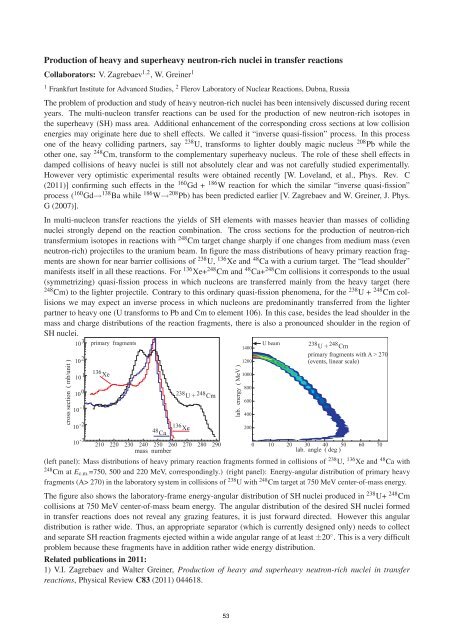FIAS Scientific Report 2011 - Frankfurt Institute for Advanced Studies ...
FIAS Scientific Report 2011 - Frankfurt Institute for Advanced Studies ...
FIAS Scientific Report 2011 - Frankfurt Institute for Advanced Studies ...
Create successful ePaper yourself
Turn your PDF publications into a flip-book with our unique Google optimized e-Paper software.
Production of heavy and superheavy neutron-rich nuclei in transfer reactions<br />
Collaborators: V. Zagrebaev 1,2 , W. Greiner 1<br />
1 <strong>Frankfurt</strong> <strong>Institute</strong> <strong>for</strong> <strong>Advanced</strong> <strong>Studies</strong>, 2 Flerov Laboratory of Nuclear Reactions, Dubna, Russia<br />
The problem of production and study of heavy neutron-rich nuclei has been intensively discussed during recent<br />
years. The multi-nucleon transfer reactions can be used <strong>for</strong> the production of new neutron-rich isotopes in<br />
the superheavy (SH) mass area. Additional enhancement of the corresponding cross sections at low collision<br />
energies may originate here due to shell effects. We called it “inverse quasi-fission” process. In this process<br />
one of the heavy colliding partners, say 238 U, trans<strong>for</strong>ms to lighter doubly magic nucleus 208 Pb while the<br />
other one, say 248 Cm, trans<strong>for</strong>m to the complementary superheavy nucleus. The role of these shell effects in<br />
damped collisions of heavy nuclei is still not absolutely clear and was not carefully studied experimentally.<br />
However very optimistic experimental results were obtained recently [W. Loveland, et al., Phys. Rev. C<br />
(<strong>2011</strong>)] confirming such effects in the 160 Gd + 186 W reaction <strong>for</strong> which the similar “inverse quasi-fission”<br />
process ( 160 Gd→ 138 Ba while 186 W→ 208 Pb) has been predicted earlier [V. Zagrebaev and W. Greiner, J. Phys.<br />
G (2007)].<br />
In multi-nucleon transfer reactions the yields of SH elements with masses heavier than masses of colliding<br />
nuclei strongly depend on the reaction combination. The cross sections <strong>for</strong> the production of neutron-rich<br />
transfermium isotopes in reactions with 248 Cm target change sharply if one changes from medium mass (even<br />
neutron-rich) projectiles to the uranium beam. In figure the mass distributions of heavy primary reaction fragments<br />
are shown <strong>for</strong> near barrier collisions of 238 U, 136 Xe and 48 Ca with a curium target. The “lead shoulder”<br />
manifests itself in all these reactions. For 136 Xe+ 248 Cm and 48 Ca+ 248 Cm collisions it corresponds to the usual<br />
(symmetrizing) quasi-fission process in which nucleons are transferred mainly from the heavy target (here<br />
248 Cm) to the lighter projectile. Contrary to this ordinary quasi-fission phenomena, <strong>for</strong> the 238 U + 248 Cm collisions<br />
we may expect an inverse process in which nucleons are predominantly transferred from the lighter<br />
partner to heavy one (U trans<strong>for</strong>ms to Pb and Cm to element 106). In this case, besides the lead shoulder in the<br />
mass and charge distributions of the reaction fragments, there is also a pronounced shoulder in the region of<br />
SH nuclei.<br />
(left panel): Mass distributions of heavy primary reaction fragments <strong>for</strong>med in collisions of 238 U, 136 Xe and 48 Ca with<br />
248 Cm at Ec.m.=750, 500 and 220 MeV, correspondingly.) (right panel): Energy-angular distribution of primary heavy<br />
fragments (A> 270) in the laboratory system in collisions of 238 U with 248 Cm target at 750 MeV center-of-mass energy.<br />
The figure also shows the laboratory-frame energy-angular distribution of SH nuclei produced in 238 U+ 248 Cm<br />
collisions at 750 MeV center-of-mass beam energy. The angular distribution of the desired SH nuclei <strong>for</strong>med<br />
in transfer reactions does not reveal any grazing features, it is just <strong>for</strong>ward directed. However this angular<br />
distribution is rather wide. Thus, an appropriate separator (which is currently designed only) needs to collect<br />
and separate SH reaction fragments ejected within a wide angular range of at least ±20 ◦ . This is a very difficult<br />
problem because these fragments have in addition rather wide energy distribution.<br />
Related publications in <strong>2011</strong>:<br />
1) V.I. Zagrebaev and Walter Greiner, Production of heavy and superheavy neutron-rich nuclei in transfer<br />
reactions, Physical Review C83 (<strong>2011</strong>) 044618.<br />
53
















